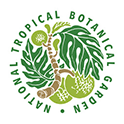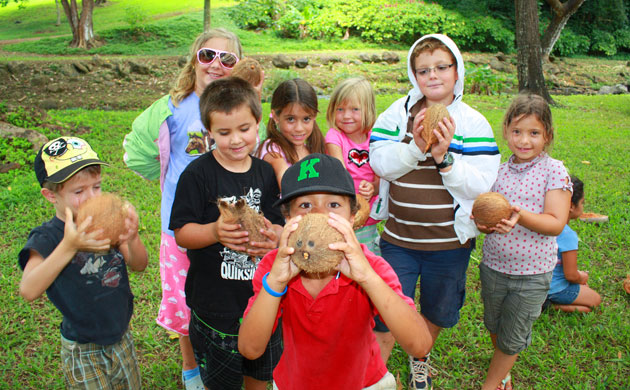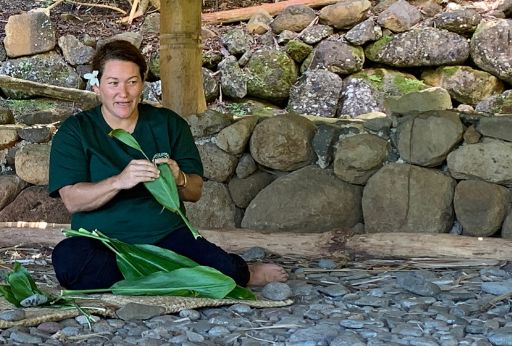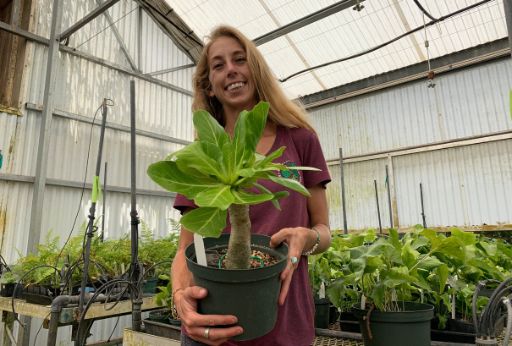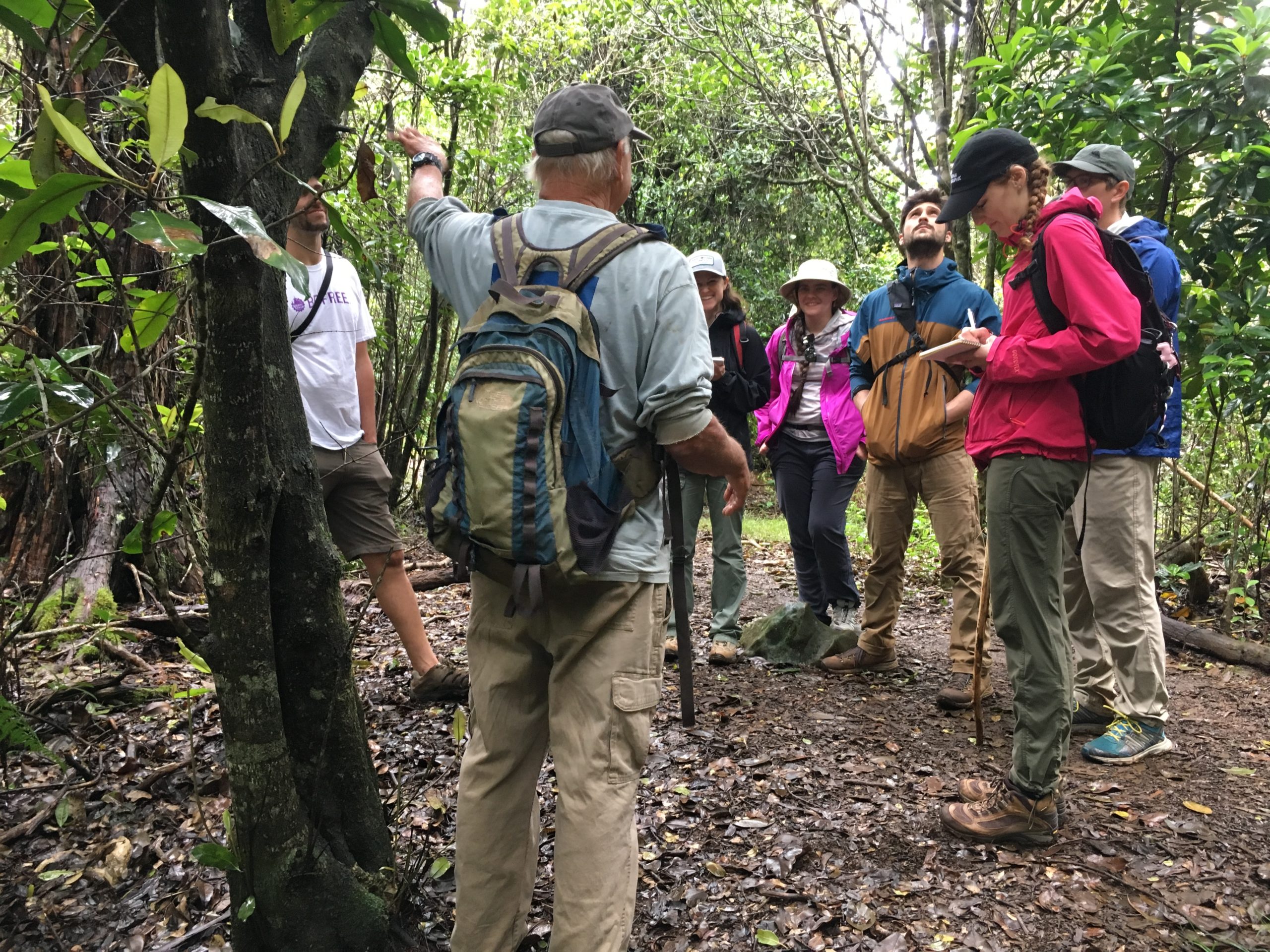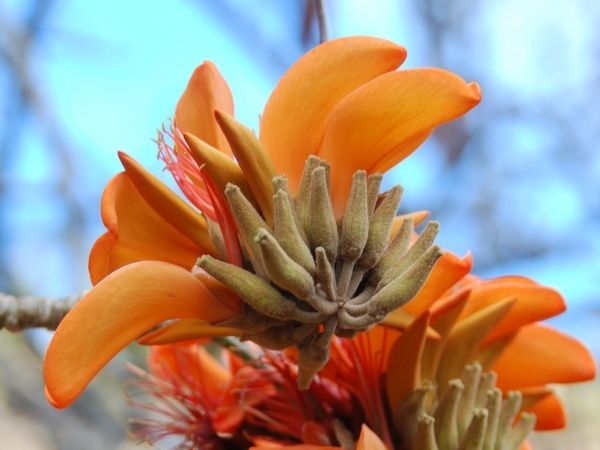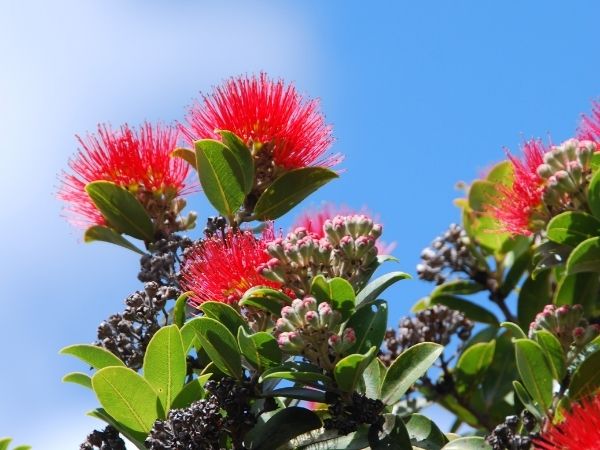Featured Plant
Colocasia esculenta (ARACEAE)
The most important plant to the Hawaiian people is kalo, most commonly known as taro, because it is linked to their very existence. According to Hawaiian legend, kalo was the firstborn son of W?kea (sky father) and Papa (earth mother)…
More info >>Featured Plant
Polyscias racemosa (ARALIACEAE)
This species occurs naturally no place else on Earth but Kaua‘i. The tree may have once grown all over the island, but today about 100 trees grow in only four wild locations including Na Pali Coast and Waimea Canyon. It…
More info >>Featured Plant
Hibiscus kokio subsp. saintjohnianus (MALVACEAE)
Koki`o `ula `ula is an attractive shrub or small tree. This hibiscus has bright orange, orange-red or yellow flowers and slightly hairy leaves and stems and short bracts. This subspecies is endemic to the island of Kaua'i and restricted to…
More info >>Featured Plant
Metrosideros polymorpha (MYRTACEAE)
There may be no more widely recognized native Hawaiian tree than the beloved `ōhi`a lehua. This beautiful member of the myrtle family earned its species name because it assumes many forms, depending upon where it grows, and ranges from towering…
More info >>Featured Plant
Theobroma cacao (MALVACEAE)
The botanical name for this plant is no accident. Theobroma means 'food of the gods'. Most would agree the cacao tree produces a most heavenly bean, for it is from cacao that chocolate is made. Humans have been consuming cacao…
More info >>Featured Plant
Heliconia caribaea (HELICONIACEAE)
Lobster claw heliconia has tall, broad leaves that point skyward and are accompanied by thick, strong flower stalks which bear big, waxy colored bracts (modified leaf-like structure). These surround small, inconspicuous flowers that are pollinated by hummingbirds, bats, or other…
More info >>Featured Plant
Artocarpus altilis (MORACEAE)
The potential of breadfruit as a food staple for the hundreds of millions hungry or malnourished people in the world's tropical regions is an important focus for NTBG’s Breadfruit Institute. Kahanu is home to the world's largest collection of breadfruit,…
More info >>Featured Plant
Lobelia niihauensis (CAMPANULACEAE)
Today this species is known to grow in the wild only on O`ahu and Kaua`i, but once also grew on the small island of Ni`ihau. Designated an endangered species, it is the subject of a recovery plan that would include…
More info >>Featured Plant
Cocos nucifera (ARECACEAE)
A member of the palm family, coconut palms grow in greatest concentrations near the equator. Contrary to popular belief, niu (the Hawaiian name for coconut) was introduced to the Hawaiian Islands by the ancient Polynesian voyagers who settled the islands.…
More info >>Featured Plant
Cordyline fruticosa (ASPARAGACEAE)
The Hawaiian name for this plant is kī or lā`i, but it is more commonly known throughout in Polynesia as ti. One of the roughly 30 Polynesian introduced plants (known as canoe plants), it is seen throughout low- and medium-elevation…
More info >>Featured Plant
Ipomoea batatas (CONVOLVULACEAE)
‘Uala (sweet potato) has been called “the second Hawaiian staple.” This tuberous root plant is extremely adaptable and can thrive in dry conditions and sand or ash-based soil, making it a suitable starch source. The running vines are an attractive…
More info >>Featured Plant
Piper methysticum (PIPERACEAE)
The first Polynesians to reach Hawai`i brought plants valued for their medicinal uses, one very important one being `awa, pronounced 'ah-vah', meaning bitter. This plant is used for its relaxing effects by Pacific Island people. The most common method is…
More info >>Featured Plant
Saccharum officinarum (POACEAE)
There are numerous varieties of sugar cane. Kō honua‘ula is one distinctive sugar cane variety with a dark purple stem and purple leaves. Kō means 'sugar cane' and honua‘ula literally means 'red earth'. The alternate name kō niho puhi means…
More info >>Featured Plant
Crinum asiaticum var. pedunculatum (AMARYLLIDACEAE)
There are more than 100 Crinum species worldwide, yet the variant enjoyed in Hawai`i is known as the Queen Emma lily because of the Queen’s reputation for loving the color purple. She is believed to have planted trees and shrubs…
More info >>Featured Plant
Etlingera elatior (ZINGIBERACEAE)
Although there are no forms of ginger native to Hawai`i, plants in the ginger family grow well there and are often associated with these islands. One of the most impressive, and certainly among the tallest, gingers is this torch ginger.…
More info >>Featured Plant
Ixora casei (RUBIACEAE)
Favored by gardeners for its continuous floral display, ever-blooming ixora is one of the most widely used horticultural plants in landscaping in Hawai`i. It grows as an evergreen shrub or small tree but can be trained into a hedge. This…
More info >>Featured Plant
Scaevola taccada (GOODENIACEAE)
One of the most common coastal plants in the Pacific Islands is known in Hawai‘i as naupaka. This dense, spreading shrub typically grows low to the ground in patches. The bright green leaves are somewhat succulent and waxy. Naupaka's flowers…
More info >>Featured Plant
Cochlospermum vitifolium (BIXACEAE)
The buttercup tree flourishes in drought-prone, rocky soils. It has conspicuous, bowl-like yellow flowers (up to 5 inches across), which are a favorite among honey bees. Blooming is soon followed by the emergence of deep green foliage that offers shade.…
More info >>Featured Plant
Brugmansia ×candida (SOLANACEAE)
Angel's trumpet is an attractive medium-size tree which bears fantastic trumpet-shaped flowers that range from orange to yellow, pink, and white. The prominent eye-catching blossoms can measure over 12 inches long and hang like colored floral pendulums. These may be…
More info >>Featured Plant
Malpighia emarginata (MALPIGHIACEAE)
Native to Mexico, Central America, Brazil, and the Caribbean, Barbados cherry is a small ornamental tree with arching limbs and dark green leaves. Its pinwheel-like pink flowers with bright yellow stamens – which are highly attractive to pollinating honey bees…
More info >>Featured Plant
Saraca indica (FABACEAE)
The ashoka tree grows under larger trees and along streams in rain forests from India to Southeast Asia. Highly prized as an attractive evergreen tree for its handsome foliage and fragrant flowers, the emergence of bright orange-yellow to red blooms…
More info >>Featured Plant
Manilkara zapota (SAPOTACEAE)
Sapodilla is an attractive evergreen tree with a widely spreading canopy of dark green leaves. From small, yellowish, bell-shaped flowers arise round to oval, rough-skinned, seed-filled fruits containing juicy, brownish flesh with a flavor reminiscent of a pear. All parts…
More info >>Featured Plant
Tamarindus indica (FABACEAE)
While the exact origin of tamarind is uncertain, the tree is probably native to tropical Africa and reached other parts of the world through human transport. A slow-growing evergreen tree, tamarind is long-lived and produces dense, spreading canopies with drooping…
More info >>Featured Plant
Artocarpus heterophyllus (MORACEAE)
Jackfruit is one member of the mulberry family sure to leave a strong impression. Bearing bumpy green oblong fruits often as large or larger than a good-sized watermelon (some say the size of a duffel bag), jackfruit seems to defy…
More info >>Featured Plant
Samanea saman (FABACEAE)
One of the most popular canopy trees in Hawai'i's gardens and parks is the monkey pod, a member of the legume family. Because monkey pod trees grow quickly and can reach up to 80 feet with broad umbrella-like canopies, they…
More info >>Featured Plant
Entada rheedei (FABACEAE)
Rare is the person who can walk past the St. Thomas bean without pausing to marvel or ask "what is that?!" This very large liana (long-stemmed woody vine) grows like a thick tangle of curlicue botanical cables, using a nearby…
More info >>Featured Plant
Cassia fistula (FABACEAE)
Commonly known as the golden shower tree, this species is a member of the bean family. When in bloom, it exhibits a profusion of light, airy bright yellow blossoms. The tree is valued for its ornamental and medicinal qualities around…
More info >>Featured Plant
Argemone glauca (PAPAVERACEAE)
In Hawaiian, this native plant is called pua kala (literally rough flower). It is a member of the poppy family. This species was the first Hawaiian plant collected by a naturalist traveling with Captain Cook during his first voyage to…
More info >>Featured Plant
Kokia kauaiensis (MALVACEAE)
The hau hele`ula is very large when compared to the similar-looking hibiscus. Found only on the west side of Kaua`i in five valleys, this species is known to have fewer than 100 remaining individuals in six populations. The genus Kokia…
More info >>Featured Plant
Nelumbo nucifera (NELUMBONACEAE)
Few sights evoke the admiration of a newly opened lotus blossom. Nelumbo nucifera is often called the 'sacred' lotus because of its association with spirituality, especially as a Buddhist and Hindu symbol. Deities and Buddha images are depicted sitting on…
More info >>Ready to explore some really cool tropical plants? Browse the tropical plant database by selecting one or more search criteria.

